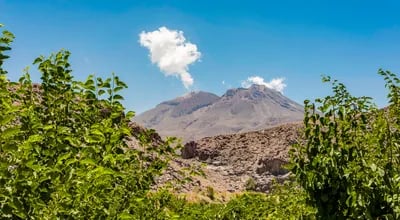GLOBISCOPE
The Sleeping Giant Stirs: Iran’s Taftan Volcano Shows First Signs of Activity After 700,000 Years
WORLD
Globiscope
10/17/20252 min read


After hundreds of thousands of years of silence, Iran’s Taftan Volcano is showing its first signs of awakening — and scientists say this could mean the “sleeping giant” is far from dormant.
Located in southeastern Iran near the Pakistan border, Mount Taftan stands 3,940 meters (12,927 feet) tall and is the only active volcano in the Makran volcanic arc, a chain of volcanoes formed where the Arabian tectonic plate slowly slides beneath the Eurasian plate. Though long considered inactive, new research reveals the mountain is stirring beneath the surface.
Magma Pressure Causes Mysterious Swelling
A team of volcanologists has discovered that Taftan’s summit swelled by nearly 9 centimeters (3.5 inches) between July 2023 and May 2024, according to satellite data. This unusual bulging suggests rising pressure from magma and hot gases deep inside the volcano.
Interestingly, researchers describe this deformation as “spontaneous” and “triggerless.” Normally, volcanic unrest is linked to events such as earthquakes, heavy rainfall, or groundwater changes — but Taftan’s swelling appears to have occurred without any clear external cause.
The scientists believe this could be the result of steam and hot water pockets building pressure underground, forcing magma upward and causing the volcano’s upper layers to expand.
A Volcano Thought to Be Long Dead
Historical records show that Taftan has been faintly active in the past. There were reports of smoke emissions in 1902 and an unconfirmed lava flow in 1993, but no major eruption has ever been witnessed in human history. In fact, experts estimate the last large eruption occurred around 700,000 years ago, long before modern humans existed.
However, the new findings indicate that Taftan may not be as dormant as once believed.
> “Our findings reveal that Taftan is more active than previously recognized,” the study’s authors explained.
Why This Discovery Matters
While there’s no immediate threat of an eruption, scientists warn that the volcano’s reawakening highlights an urgent need for better monitoring and risk assessment in the region.
Researchers recommend installing advanced volcano monitoring networks, updating geological hazard maps, and preparing emergency response plans for surrounding communities in Iran and Pakistan.
> “This highlights the urgent need for a revision of the current volcano risk assessment of the Makran subduction zone,” the researchers said.
A Reminder From Beneath the Earth
The Taftan volcano’s sudden activity serves as a powerful reminder that Earth’s geological forces never truly rest. Even after 700,000 years of calm, a sleeping volcano can stir again — and when it does, it demands our attention.
The full findings are published in the journal [insert journal name when available].
Globiscopes news 2025
Globiscopes news empowers the generation of tomorrow for a brighter future and hope for every individual.
inbox
Subscribe to our newsletter and never miss a story.
We care about your data in our privacy policy.
